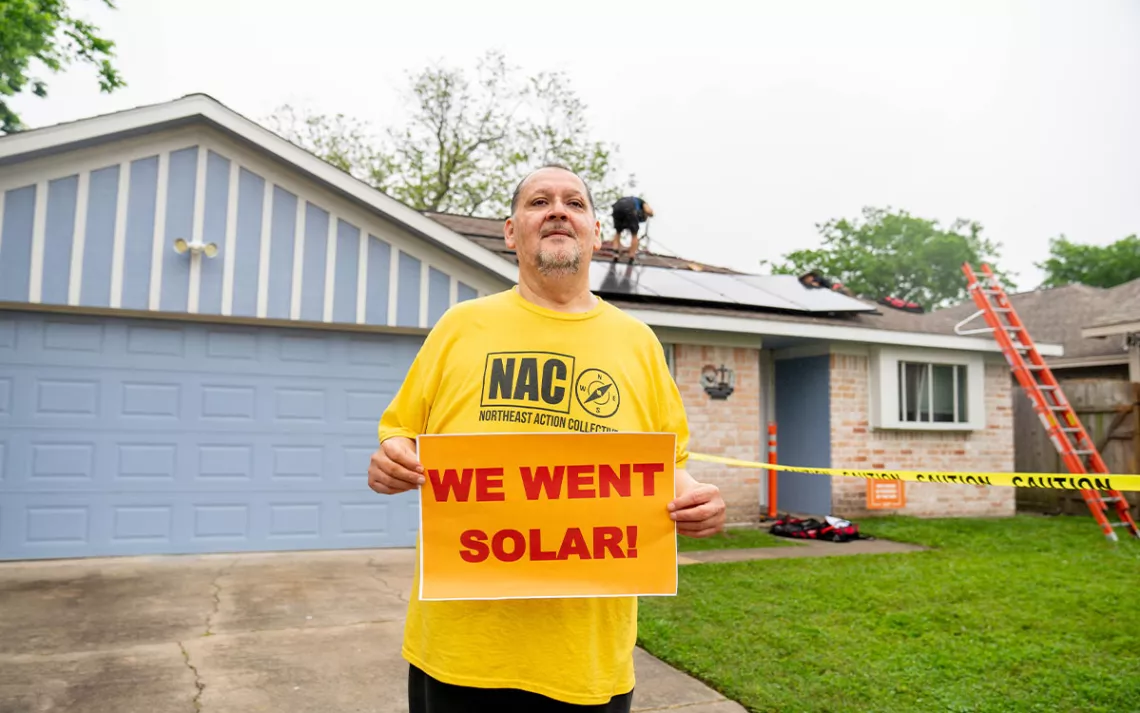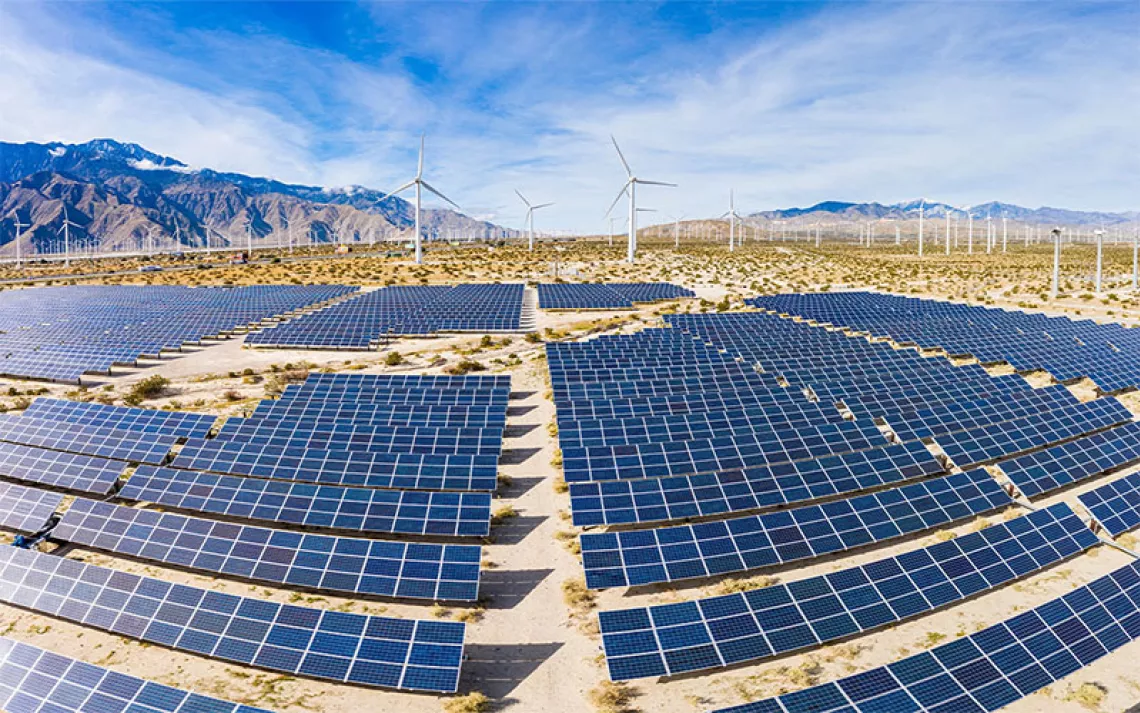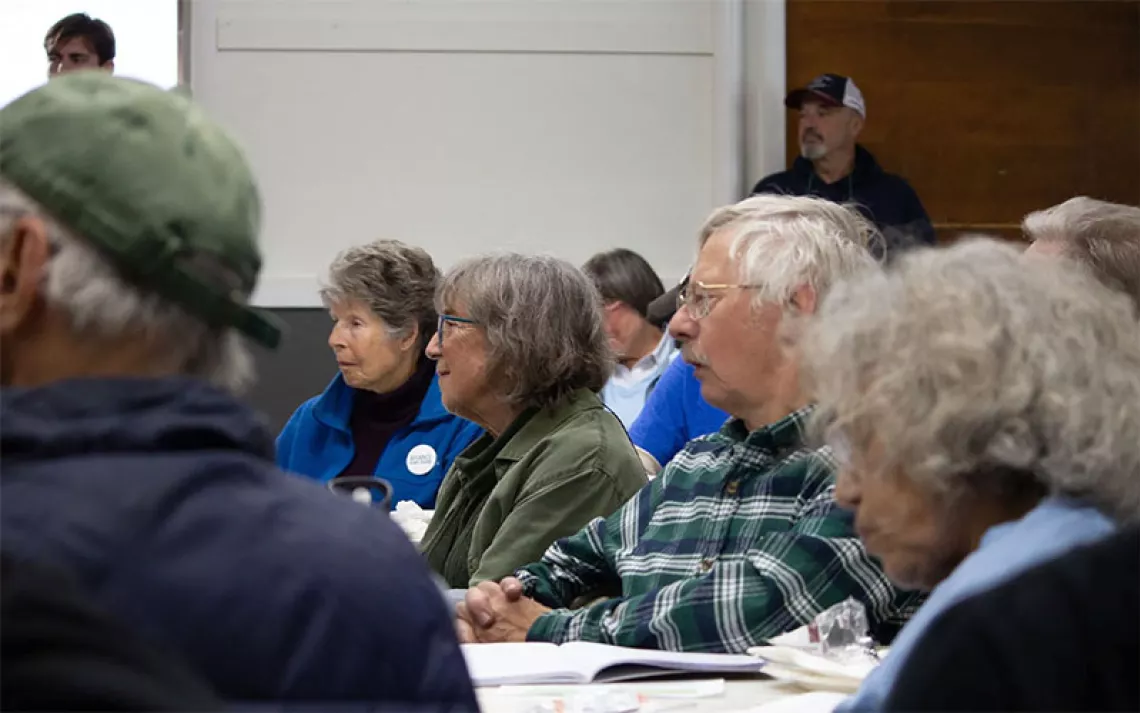How Communities Can Power Their Own Just Clean Energy Transition
The climate crisis presents an opportunity to rewrite everything from ownership to energy independence

Northeast Houston resident and solar co-op member Rolando Perez outside his home as installers put the finishing touches on his new rooftop solar array. | Photo courtesy of Solar United Neighbors
Jessica Night never thought she’d be able to go solar. A Minneapolis-based artist with a blended family that includes six kids, she says, “I’m pretty lower income. I never thought that there was a way that I would be able to do it.”
That changed in fall 2020 when the City of Lakes Community Land Trust, through which Night became a homeowner, sent out an email about a solar workshop held by Solar United Neighbors (SUN), a nonprofit that organizes groups of homeowners across the country into temporary co-ops that go solar at the same time. By doing so, SUN secures competitive bids from local installers that greatly reduce the costs of getting rooftop solar. By the summer of 2021, Night had solar panels on her roof and became one of now 8,500 other homeowners across the country—from more than 409 co-ops—who SUN has helped transition into a new home energy source. (Disclosure: My household also installed solar panels through a SUN co-op.)
Organizations doing similar work at the state level also see the climate crisis and the clean energy transition it demands as an opportunity for social and economic justice. In Minnesota, Cooperative Energy Futures takes a statewide co-op approach to community solar projects, and in California, People Power Solar runs a mutual-aid-style battery sharing program, among other initiatives.
While solar installations have grown by 24 percent across the US in the last decade, just 4.2 million single-family homes out of the eligible 84.69 million homes across the country have solar. As of 2022, fossil fuels still account for roughly 81 percent of the primary energy production in the US and, as of 2021, 79 percent of the US’s total energy use. To close the gap between today’s utility landscape and a clean energy future, community-based programs like these are creating co-ops, shepherding subsidies, and organizing people along the way.
“We believe the core players in the business transaction are the people who are using the service. That’s a fundamental shift in how we think about ownership,” says Timothy DenHerder-Thomas, general manager of Cooperative Energy Futures. “In a traditional capitalist economy, the person who gets the surplus is the person who puts the most in on the front end … but, no. It’s the customer who’s paying for that service day in and day out that makes the business profitable.”
SUN carries out this broader work in a number of ways. In Florida, it worked to pass a law that bans homeowners’ associations from prohibiting residents from installing solar. In Minnesota, its advocacy resulted in changes to the state’s income-qualified Solar Rewards program, making it more accessible to lower-income households and increasing the incentives for installing rooftop solar. Across SUN’s co-ops, it negotiates with installers to allow low-income co-op members to pay a small, refundable down payment on their system and to defer full payment until they have received all the incentives they’re eligible for, dramatically reducing otherwise burdensome upfront costs.
“We have the potential to break power down into the neighborhood scale, the community scale, for people to have what some call energy independence,” says Crystal Huang, cofounder and CEO of People Power. For Huang, that’s energy supplied directly to the user, free from corporate profit margins.
She explains that while some might think that the key to a clean energy future is only solar on every rooftop, for People Power, it’s also about rethinking our relationship with power, ownership, and governance.
“Our current energy system isn’t really equitable, and the future won’t necessarily be equitable either if we’re not very intentional,” explains Erin Baker, faculty director of the University of Massachusetts Amherst’s Energy Transition Institute. “Community-based approaches [to the clean energy transition] are important in a number of dimensions, but especially with a focus on traditionally marginalized communities.”
The fossil fuel industry oppresses Indigenous communities in particular, who have repeatedly had their treaty rights trampled in the name of pipeline development. As Amnesty International notes, Indigenous people “are disproportionately impacted by fossil fuel exploration and extraction because political [marginalization] makes it harder for them to oppose it.” Despite the extraction that takes place on their lands, Indigenous people rarely see the financial benefits. One in four live in poverty across the country. Already the highest poverty rate for any racial group, those numbers only increase on reservations because of limited economic opportunities.
GRID Alternatives, a community-based nonprofit with a vision of an equitable renewable energy transition, works to address these disparities through its Tribal Program. The formal effort launched in 2010 after years of tribes reaching out to GRID to better understand how they could plan for a renewable energy future.
One of the main challenges they face are barriers to accessing state and federal incentives. Not only must they first connect to a regional electrical grid (an expensive and onerous process) but also “tribes have their own sovereign policies and regulations that don’t necessarily align with a state utility,” explains Tanksi Clairmont, co-executive director of GRID’s national tribal program. Tribes often don’t have the capacity to staff grant writers, program managers, and other personnel necessary for securing US government funding.
GRID focuses on building capacity as directed and needed by the tribal communities themselves. Clairmont’s team (which is almost entirely Indigenous) partners with tribal colleges and workforce development programs to offer hands-on solar training, makes connections to local solar companies, works with K-12 schools to introduce students to renewable energy, and more.
GRID also works with tribes to make applying for funding from the millions of dollars awarded to GRID as flexible and easy as possible. Plus, “the construction crews from our tribal programs come from these communities that we serve,” Clairmont says. “Not only are we providing grant funding to over 85 tribes, we’re building a community of tribes that all have similar goals for developing their own renewable energy infrastructure.”
Cooperative Energy Futures also works to create community by bringing residents from across Minnesota together into a co-op that facilitates community-owned solar projects everywhere from farmland to parking lots. The organization weaves together traditional loans from banks, philanthropic funding, and partnerships with corporate entities that can benefit from tax credits, blending that with power purchase agreements with members.
The power purchase agreements allow members—renters, homeowners, or anyone else across the state—to pay the co-op for a portion of the energy generated by a project. The member is credited for their contribution on their energy bill, which often zeros out the cost of their usage. This results in members paying less for clean energy than they did before for traditional energy. Cooperative Energy Futures benefits too, because it nets enough funding to pay all the operating and maintenance costs as well as pay down the original loans it took out to make the project happen. “At the end of the day, it generates profit for Cooperative Energy Futures that’s then distributed to our members,” says DenHerder-Thomas.
What’s been central to these organizations’ successes has been their ability to earn the trust of the communities they organize and serve. Then, it’s about what that hard-earned trust is used to build: a more democratic, decentralized, and just energy future.
 The Magazine of The Sierra Club
The Magazine of The Sierra Club



